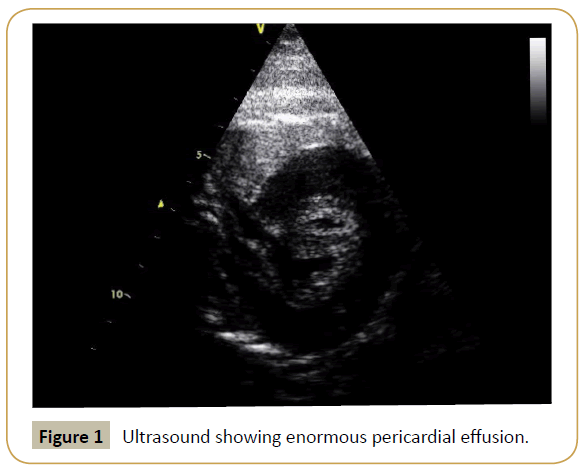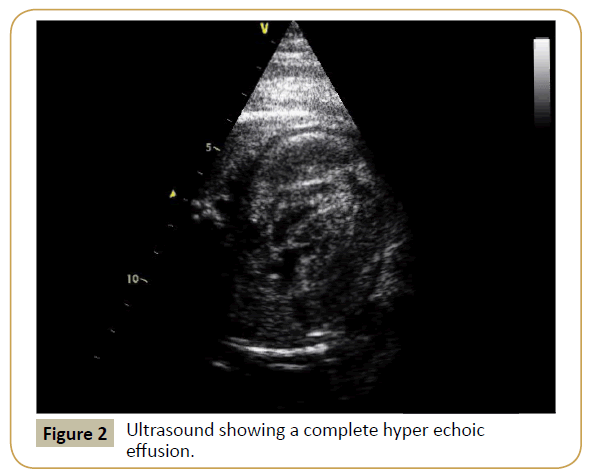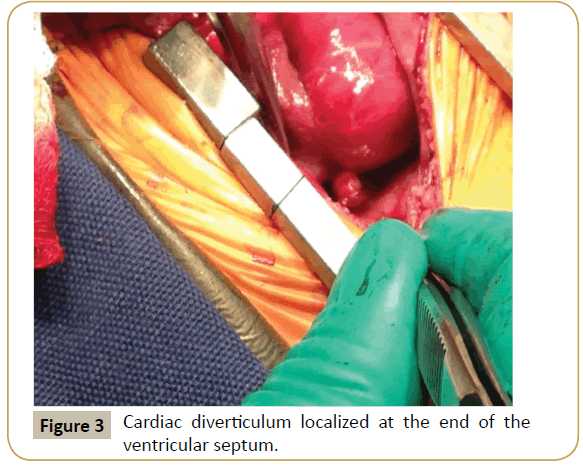L Daou*, N Hanna, H Sayah and I Melki
Department of Pediatrics, Hotel Dieu de France Hospital, Beirut, Lebanon
Received date: December 07, 2015; Accepted date: December 16, 2015; Published date: December 23, 2015
- Corresponding Author:
- L Daou
Pediatric cardiologist
- Department of pediatrics
Hotel Dieu de France Hospital
Beirut, Lebanon
E-mail: lindadaou@hotmail.com
Keywords
Cardiac diverticulum; Pericardial effusion; Active pericardial bleeding, Tamponade
Case Report
A healthy 26-year-old woman, gravida 2 para 2 aborta 0, with a good course of pregnancy. An ultrasound done at 35 weeks of gestation was normal. In a routine third trimester ultrasound, done at 36 weeks of gestation, the fetus presented with a minimal pericardial effusion.
The second day, the ultrasound was repeated by another obstetrician, with the same minimal cardiac effusion, a good heart rate and normal systolic function.
On the same afternoon, the mother was referred to a pediatric cardiologist for assessment. An ultrasound done showed that the pericardial effusion had become enormous, causing cardiac tamponade and severe bradycardia (30 beats/min), without architectural anomalies (Figure 1).
During the exam, the cardiologist observed that the effusion, previously hypo echoic, was progressively becoming hyper echoic, before turning into a complete hyper echoic effusion 10 minutes after (Figure 2).
These results proved that the fetus was experiencing an active pericardial bleeding at the time of the ultrasound.
Considering the life-threatening nature of the situation, the mother was sent to Hotel Dieu de France for an urgent C-section.
An obstetrician, a neonatal pediatrician and a pediatric cardiac surgeon along with the pediatric cardiologist stood ready to handle the case.
A C-section was performed and the baby girl was born with an Apgar score of 7 and 9, at 1 and 5 minutes of birth respectively. A cardiac ultrasound done at birth showed the same hyper echoic structure, surrounded by a new pericardial effusion.
In view of the case, the C-section was exceptionally performed in the cardio-vascular operating theater so that the newborn can be directly transferred to the adjacent operating room.
At the start of surgery, the newborn was hemodynamically unstable. As soon as the pericardial effusion was drained (30 ml of bloody fluid followed by blood clots), the patient became stable. A cardiac diverticulum was found localized at the end of the ventricular septum, taking its origin from the right ventricle (Figure 3).
Figure 1: Ultrasound showing enormous pericardial effusion.
Three stitches were done on the diverticulum to stop the bleeding. Good course of the surgery, done in one hour 20 minutes.
The newborn was transferred to the neonatal intensive care unit for medical supervision. Good course in the hospital, no complications during her stay at the intensive care unit. A cardiac ultrasound done at day 4 of life showed no pericardial effusion and a normal systolic function. She left the hospital at day 5 of life. At the time of writing, the child was asymptomatic and in a good general health.
Discussion
Cardiac ventricular diverticula are localized protrusions of the wall of the cardiac ventricles with a narrow connection to the ventricle. They are usually isolated lesions [1-3].
Figure 2: Ultrasound showing a complete hyper echoic effusion.
Figure 3:Cardiac diverticulum localized at the end of the ventricular septum.
Congenital protrusion of the cardiac ventricular wall has been variably defined in the literature as diverticulum or aneurysm.
The real incidence of these conditions is not known, since many cases may be asymptomatic [4-7].
The etiology of cardiac diverticula and aneurysms in fetal life is poorly understood. They may occur as result of focal weakening of the ventricular wall due to an interruption during embryogenesis, infection [8-10], or from localized ischemia of the ventricular wall from diseased coronary arteries such as stenosis, hypoplasia or intimal proliferation [8-11]. Most cardiac diverticula have been reported from mid-gestation [4,12].
A common mode of presentation is an abnormal four-chamber view, but they can also be associated with fetal arrhythmias [13,14], pericardial effusions [4] or even fetal hydrops [12].
The prognosis of diverticula is usually good, but it will depend on location, associated abnormalities, signs of cardiac impairment and evolution during pregnancy.
Postnatal surgical intervention may be necessary. There are, however, few reports in early pregnancy, some leading to termination [4,12].
References
- Teske DW, McGovern JJ, Allen HD (1993)Congenital fibrous leftventricular diverticulum. Am Heart J126: 1233-1235.
- Hallali P, Iung B, Davido A, Binet JP, Leriche H, et al. (1989)Congenital diverticulum of the right ventricle: report of twocases associated with other congenital defects. Am Heart J117: 957-959.
- Nicod P, Laird WP, Firth BG, Fixler D (1984) Congenital diverticulaof the left and right ventricle: 3 cases. Am J Cardiol53:342-344.
- Cavalle-Garrido T, Cloutier A, Harder J, Boutin C, SmallhornJF (1997) Evolution of fetal ventricular aneurysms and diverticulaof the heart: an echocardiographic study. Am J Perinatol14: 393-400.
- Matias A, Fredouille C, Nesmann C, Azancot A (1999) Prenataldiagnosis of left ventricular aneurysm: a report of three casesand a review. Cardiol Young9: 175-184.
- McElhinney DB, Silverman N (1999) Left ventricular aneurysm inthe fetus: a diagnosis with a mixed prognosis. Cardiol Young9: 123-126.
- Brachlow A, Sable C, Smith S, Slack M, Martin G (2002)Fetaldiagnosis and postnatal follow-up of an asymptomaticcongenital left ventricular diverticulum. Pediatr Cardiol23: 658-660.
- Gembruch U, Steil E, Redel DA, Hansmann M (1990) Prenatal diagnosisof a left ventricular aneurysm. PrenatDiagn10:203-209.
- Treistman B, Cooley DA, Lufschanowski R, Leachman RD (1973)Diverticulum or aneurysm of the left ventricle. Am J Cardiol32: 119-123.
- Mardini MK (1984)Congenital diverticulum of the left ventricle.Report of two unusual cases. Br Heart J51: 321-326.
- Cavalle-Garrido T, Cloutier A, Harder J, Boutin C, SmallhornJF (1997) Evolution of fetal ventricular aneurysms and diverticulaof the heart: an echocardiographic study. Am J Perinatal14: 393-400.
- Sepulveda W, Drysdale K, Kyle PM, McNeal AD, Moore IE (1996)Congenital left ventricular aneurysm causing hydropsfetalis:prenatal diagnosis with color Doppler ultrasonography. JUltrasound Med15: 327-331.
- Tsujimoto H, Takeshita S, Kawamura Y, Nakatani K, Sato M (2000)Isolated congenital left ventricular diverticulum with perinataldysrhythmia: a case report and review of the literature. PediatrCardiol21: 175-179.
- John JB, Bricker JT, Fenrich AL, Vick GW, El-Said HG,et al. (2002) Images in cardiovascular medicine.Fetal diagnosis of right ventricular aneurysm associated withsupraventricular tachycardia with left bundle-branch blockaberrancy. Circulation106: 141-142.




